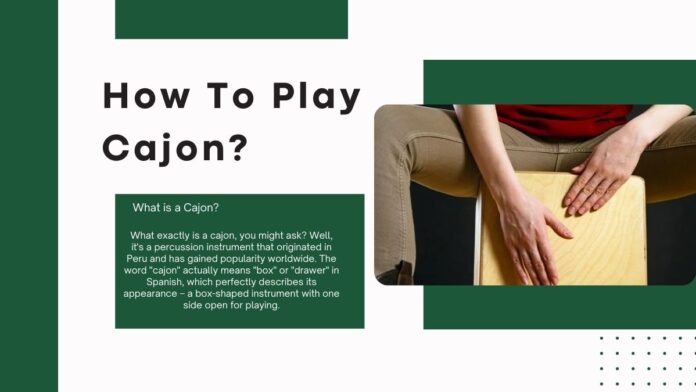Welcome to the world of rhythm and percussion! If you’ve ever been captivated by the infectious beats of Latin music or mesmerized by the pulse of acoustic performances, then you’re in for a treat.
Today, we’re going to dive into the captivating world of playing the Cajon – a versatile and portable instrument that will have you tapping your feet and grooving along in no time.
Whether you’re a seasoned musician looking to expand your repertoire or someone completely new to the world of percussion, this guide will walk you through everything you need to know about playing the Cajon.
From understanding its origins and unique sound possibilities to learning essential techniques, get ready to unleash your inner performer as we embark on this rhythmic journey together. So grab a seat (preferably on a Cajon!) and let’s dive right in!
What is a Cajon?
What exactly is a cajon, you might ask? Well, it’s a percussion instrument that originated in Peru and has gained popularity worldwide. The word “cajon” actually means “box” or “drawer” in Spanish, which perfectly describes its appearance – a box-shaped instrument with one side open for playing.
Traditionally, the Cajon was made from simple materials like plywood or fruit crates, but nowadays you can find them crafted from high-quality woods to produce richer tones. It features different playing surfaces – the front plate is where most of the action happens, while the back and sides contribute to the overall sound projection.
When played correctly, this seemingly humble box can unleash an incredible range of sounds reminiscent of drums and even other melodic instruments. By using your hands or specialized brushes called “cajón mallets,” you can create various rhythms and tones on different parts of the Cajon’s surface.
The beauty of this instrument lies not only in its simplicity but also in its versatility. Cajons are capable of producing deep bass notes as well as snappy highs and everything in between. With some practice and experimentation, you’ll discover endless possibilities for expressing yourself rhythmically through this compact yet powerful percussion instrument.
So now that we’ve acquainted ourselves with what a Cajon is let’s delve into how to play this captivating instrument!
How to Play the Cajon?
Welcome to the world of rhythm and percussion! If you’re interested in learning how to play the Cajon, you’ve come to the right place. This versatile instrument originated from Afro-Peruvian music and has gained popularity worldwide for its unique sound and portability.
To start playing the Cajon, sit on a chair or stool with your feet flat on the ground. Position the Cajon between your legs, tilted slightly forward for optimal sound projection. Place your dominant hand (right if you’re right-handed) near the top edge of the front plate. Use this hand to create different tones by striking various parts of the surface.
With your non-dominant hand, explore different techniques like slaps and finger rolls on different areas of the front plate. Experiment with these techniques to produce varying sounds that range from deep bass tones to sharp snare-like pops.
Remember, practice makes perfect! Start by learning basic rhythms such as flamenco-style patterns or simple rock beats. As you gain confidence and skill, try incorporating more complex patterns into your repertoire.
Playing the cajon not only allows you to express yourself creatively but also offers several benefits. It strengthens coordination skills between hands and feet while improving overall rhythm sense. Additionally, it can be a great stress reliever and a way to connect with others through jam sessions or performances.
So grab a Cajón today and let your inner musician shine through rhythmic expression! Explore tutorials online or consider taking lessons from experienced players who can guide you in mastering this fascinating instrument. Happy drumming!
The Different Types of Sounds You Can Make on a Cajon:
The Cajon is a versatile percussion instrument that offers a wide range of sounds and tones. With just your hands and fingers, you can create an entire rhythm section on this box-shaped drum.
One of the most basic sounds you can produce on a Cajon is the bass tone. To achieve this deep, resonant sound, strike the center of the playing surface with an open hand or use your palm to create more depth. The bass tone provides a solid foundation for any groove or beat.
Moving up from the bass tone, we have the snare sound. This can be achieved by striking closer to the edges of the playing surface with your fingertips or using brushes or rods to add texture. The snare sound adds a crisp and sharp element to your rhythms.
In addition to these fundamental sounds, there are endless possibilities for creativity on a Cajon. You can experiment with different techniques such as finger rolls, slaps, and ghost notes to create unique textures and accents within your playing.
By utilizing various parts of the Cajon’s playing surface – including corners and edges – you can further expand its sonic capabilities. Each area produces slightly different tones which allow for greater expression in your music.
Whether you’re exploring traditional flamenco rhythms or experimenting with modern percussive styles, mastering these different types of sounds will greatly enhance your versatility as a Cajon player. So grab your drum stool, find some inspiration, and let those beats flow!
Benefits of Playing the Cajon:
- Playing the Cajon offers a multitude of benefits, both for your musical skills and overall well-being. Let’s explore some of the advantages that come with mastering this versatile percussion instrument.
- Playing the Cajon is a great way to enhance your rhythm and coordination. As you tap out different beats and patterns on its wooden surface, you train your hands to move in sync with each other, improving dexterity and motor skills.
- Moreover, Cajon provides an avenue for self-expression. Whether you’re playing alone or jamming with others, you can create unique rhythms and melodies that reflect your personal style. This creative outlet allows you to connect deeply with music while showcasing your individuality.
- Another benefit is its portability. Unlike larger drums or complex instruments, the cajon is compact and lightweight, making it easy to transport to gigs or jam sessions. You can take it anywhere – from beach bonfires to acoustic performances in small venues – without breaking a sweat.
- Additionally, playing the Cajon can be therapeutic for both mind and body. The repetitive motions involved in drumming promote relaxation and stress relief by releasing endorphins – natural mood-enhancing chemicals in our brains. It becomes a form of meditation as you immerse yourself in rhythm and find inner peace through music.
- Furthermore, learning how to play the Cajon cultivates discipline and patience. Mastering new techniques takes time and practice but yields rewarding results over time. Through dedication to honing your craft, you develop perseverance that extends beyond music into various aspects of life.
Finally yet importantly – let’s not forget about fun! The joy derived from creating rhythmic beats on a simple wooden box cannot be overstated. Playing the cajon brings pure delight as it taps into our primal instincts through rhythmic expression.
Conclusion
Playing the Cajon can be a rewarding and enjoyable experience for musicians of all skill levels. This versatile instrument offers a wide range of sounds and rhythms, allowing you to express your creativity and add depth to your music.
In this article, we have explored what a Cajon is and how to play it. We discussed the different types of sounds that can be produced on a cajon, from bass tones to snare-like pops. By experimenting with hand techniques and varying pressure, you can create an array of unique sounds that will enhance your playing style.
Furthermore, we highlighted some of the benefits that come with playing the Cajon. Not only does it provide physical exercise by engaging various muscles in your body, but it also offers stress relief and improves coordination skills. Additionally, playing the Cajon allows you to connect with others through collaborative jam sessions or performances.
Whether you are a beginner looking to explore percussion instruments or an experienced musician searching for new ways to diversify your sound, learning how to play the Cajon is definitely worth considering.
So why wait? Grab a Cajón today and start exploring its rhythmic possibilities! With practice and dedication, you’ll soon find yourself grooving along effortlessly on this remarkable instrument!
Remember, playing the Cajon is not just about following rules or mastering techniques; it’s about embracing creativity and expressing yourself through rhythm. So go ahead – let loose, have fun, and make some incredible music on the magnificent Cajón!







